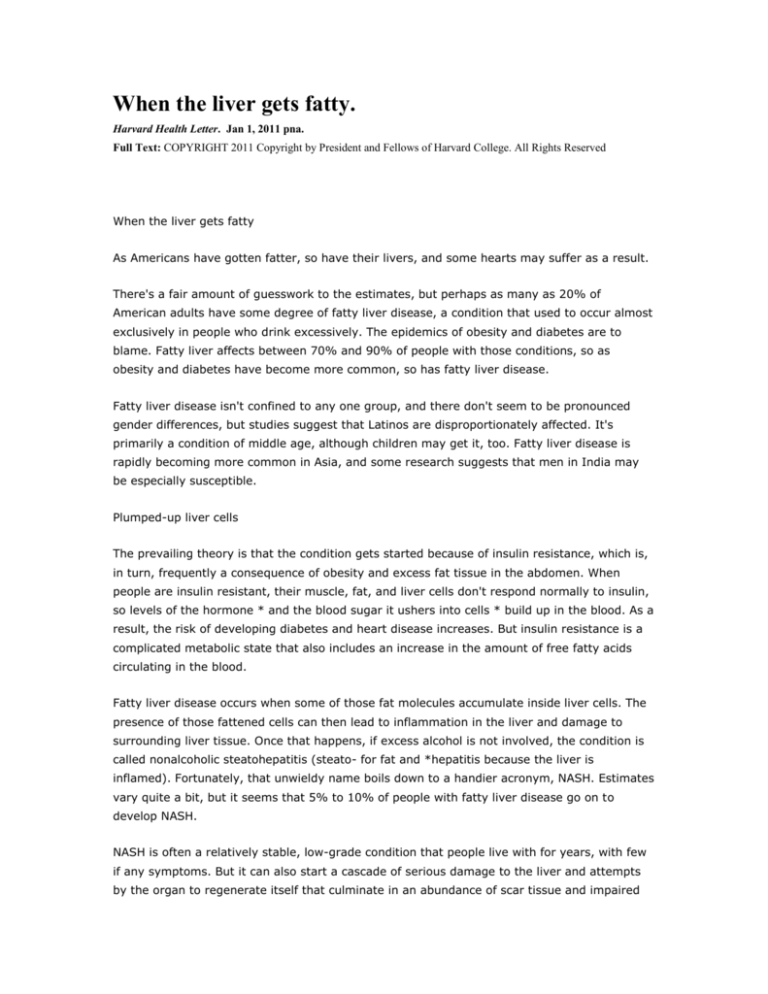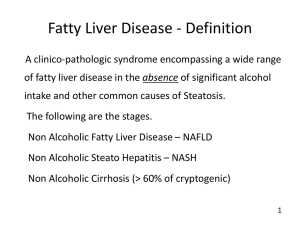
When the liver gets fatty.
Harvard Health Letter. Jan 1, 2011 pna.
Full Text: COPYRIGHT 2011 Copyright by President and Fellows of Harvard College. All Rights Reserved
When the liver gets fatty
As Americans have gotten fatter, so have their livers, and some hearts may suffer as a result.
There's a fair amount of guesswork to the estimates, but perhaps as many as 20% of
American adults have some degree of fatty liver disease, a condition that used to occur almost
exclusively in people who drink excessively. The epidemics of obesity and diabetes are to
blame. Fatty liver affects between 70% and 90% of people with those conditions, so as
obesity and diabetes have become more common, so has fatty liver disease.
Fatty liver disease isn't confined to any one group, and there don't seem to be pronounced
gender differences, but studies suggest that Latinos are disproportionately affected. It's
primarily a condition of middle age, although children may get it, too. Fatty liver disease is
rapidly becoming more common in Asia, and some research suggests that men in India may
be especially susceptible.
Plumped-up liver cells
The prevailing theory is that the condition gets started because of insulin resistance, which is,
in turn, frequently a consequence of obesity and excess fat tissue in the abdomen. When
people are insulin resistant, their muscle, fat, and liver cells don't respond normally to insulin,
so levels of the hormone * and the blood sugar it ushers into cells * build up in the blood. As a
result, the risk of developing diabetes and heart disease increases. But insulin resistance is a
complicated metabolic state that also includes an increase in the amount of free fatty acids
circulating in the blood.
Fatty liver disease occurs when some of those fat molecules accumulate inside liver cells. The
presence of those fattened cells can then lead to inflammation in the liver and damage to
surrounding liver tissue. Once that happens, if excess alcohol is not involved, the condition is
called nonalcoholic steatohepatitis (steato- for fat and *hepatitis because the liver is
inflamed). Fortunately, that unwieldy name boils down to a handier acronym, NASH. Estimates
vary quite a bit, but it seems that 5% to 10% of people with fatty liver disease go on to
develop NASH.
NASH is often a relatively stable, low-grade condition that people live with for years, with few
if any symptoms. But it can also start a cascade of serious damage to the liver and attempts
by the organ to regenerate itself that culminate in an abundance of scar tissue and impaired
liver function * a condition called cirrhosis. Cirrhosis is irreversible and can lead to total failure
of the liver. It also is associated with an increased risk for developing liver cancer.
Some studies have shown as few as 3% of people with NASH developing cirrhosis, while
others have shown as many as 26% doing so. There's no test or risk factor that predicts who
will develop cirrhosis and who won't, although one study did find that people who are older or
whose initial liver biopsies showed more inflammation were at greater risk. It's clear, though,
that the prognosis for NASH is far better than it is for steatohepatitis that's the result of heavy
alcohol consumption. Perhaps as many as half of all those with alcoholic steatohepatitis (which
lacks a handy acronym) go on to develop cirrhosis.
It's just a theory at this point, but people with fatty liver disease and NASH may need to be
more worried about heart disease and stroke than about serious liver problems. An article
published in The New England Journal of Medicine in late 2009 argued that the inflammatory
and other factors pumped out by a fat-afflicted liver promote the atherosclerotic process that
damages the insides of arteries and makes blood more likely to clot, a combination that can
lead to heart attack or stroke. The evidence the authors cited is intriguing, if circumstantial.
They pointed to a study showing that people with NASH are twice as likely to die from heart
attack or stroke as people without it. And NASH seems to add to the risks that come with
excess weight. Overweight men with NASH have higher levels of C-reactive protein, an
inflammatory factor, and fibrinogen, a clotting factor, than overweight men without NASH.
Moreover, the levels of those and other factors go up as NASH gets more severe.
The fatty liver: How it starts and what it can lead to
Abdominal obesity and metabolic syndrome* cause insulin resistance
Insulin resistance increases fatty acid levels in the blood
Fat accumulates in liver cells
Up to 20% of Americans have fatty livers
Usually there are no symptoms
Weight loss can make the liver less fatty
Excessive alcohol also make the liver fatty
Fat in liver cells causes inflammation and damage to liver tissue
The medical term is steatohepatitis (steato- for fat and -hepatitis for liver inflammation)
Steatohepatitis that's not related to alcohol is called nonalcoholic steatohepatitis, or NASH
A liver biopsy is the only way to definitely diagnose NASH
Weight loss is the main treatment. Vitamin E has shown some promise
Further liver damage results in liver fibrosis and cirrhosis
Fibrosis is a buildup of fibrous tissue; cirrhosis is a buildup of scar tissue
Between 3% and 26% of NASH patients develop cirrhosis
A small number of people with cirrhosis develop liver cancer
NASH has been linked to an increased risk of heart attack and stroke
A liver affected by NASH may produce inflammatory factors that promote the atherosclerotic
process that narrows blood vessels
NASH may be just another aspect of metabolic syndrome
The cause of NASH, not NASH itself, may increase heart attack and stroke risk
*Metabolic syndrome is abdominal obesity along with high triglycerides, high blood pressure,
high blood sugar, and low HDL cholesterol.
Diagnosis requires a biopsy
Most people with fatty liver disease don't have symptoms, and that's true even if it has
developed into NASH. Only occasionally do people feel run-down, or they have an achy feeling
in the upper right side of the abdomen, where the liver is located. So, more often than not,
fatty liver disease and NASH are discovered incidentally, starting with higher than normal
levels of liver enzymes on a routine blood test. Ultrasound imaging, the same technology used
to get pictures of developing fetuses, can be informative: the liver looks bright because the fat
shows up as white on the image. But neither an ultrasound nor a CT or MRI scan is completely
reliable for making a diagnosis. The fat in the liver is visible, but not the NASH-related
inflammation. Some researchers have developed formulas that use a simple blood test and
measurements of various hormones, inflammatory factors, and liver enzymes to arrive at a
diagnosis, but this work is at a preliminary stage.
Currently, a liver biopsy is the only way to make a definitive diagnosis of fatty liver or NASH.
Liver biopsies involve inserting a long needle into the right side of the abdomen and extracting
a small piece of liver tissue that can be examined under a microscope. Liver biopsies are an
invasive procedure, so they aren't entirely free of risk and complications, but they're also fairly
routine these days and can be done on an outpatient basis.
Whether a doctor will order a biopsy to nail down a diagnosis depends on many factors,
including whether the person is obese or has diabetes or shows other signs of liver trouble.
Weight loss is the treatment
There's been a fair amount of research into using diabetes drugs to treat NASH, even in
people who don't have diabetes. Rosiglitazone (sold as Avandia) and pioglitazone (sold as
Actos) have been the leading candidates because they reduce insulin resistance, the root
cause of fatty livers. They're not looking so promising these days. The FDA has moved to
sharply curtail the use of Avandia because it seems to cause heart problems. The results of an
important trial published in 2010 in The New England Journal of Medicine showed Actos to be
no better than a placebo in improving NASH in people without diabetes.
Another diabetes drug, metformin (Glucophage), might prove to be an effective treatment, but
there isn't enough evidence yet. Vitamin E is a possibility: the same trial that showed Actos
wasn't effective showed some improvement in the livers of people who took large doses (800
IU daily) of the vitamin. But many doctors are wary about prescribing large doses of vitamin E
because they've been associated with an increased risk of bleeding. Besides, the
improvements in the liver were limited. Fish oil has produced some favorable results, and
clinical trials are under way, but it can't be endorsed yet.
These setbacks and uncertainties have left weight loss (ideally from changes in diet and an
increase in physical activity) as the only recommended treatment for most cases of fatty liver
disease and NASH. In many cases, weight loss seems to have a very direct effect: as people
lose weight, the fatty liver becomes less fatty. Crash dieting is a bad idea, though, because
rapid weight loss (losing 4 pounds a week or more) can wind up damaging the liver. Of
course, if sustained weight loss were easy, a lot of today's health problems would be solved,
not just fatty liver disease and NASH.
In addition to encouraging people to lose weight, doctors will often advise people with diabetes
who have fatty liver disease or NASH to be vigilant about controlling their blood sugar.
The bottom line
Many parts of the body come to grief once people become obese or develop diabetes. It's not
surprising that our livers do too, given how central they are to a whole suite of metabolic
processes. There's some evidence that a fatty liver may add to the already high risk of heart
disease among people who are obese or have diabetes. Fatty livers can also develop into
cirrhotic ones if the inflammatory processes take off.
But there are two bright spots in the take-home message about fatty livers. First, most cases
stay relatively stable and don't result in serious liver disease. Second, the treatment is not an
expensive drug with side effects, but losing weight * and that will benefit many other parts of
the body besides the liver.
Record Number: A245687249








